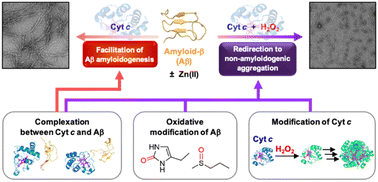Unveiling the impact of oxidation-driven endogenous protein interactions on the dynamics of amyloid-β aggregation and toxicity†
Abstract
Cytochrome c (Cyt c), a multifunctional protein with a crucial role in controlling cell fate, has been implicated in the amyloid pathology associated with Alzheimer's disease (AD); however, the interaction between Cyt c and amyloid-β (Aβ) with the consequent impact on the aggregation and toxicity of Aβ is not known. Here we report that Cyt c can directly bind to Aβ and alter the aggregation and toxicity profiles of Aβ in a manner that is dependent on the presence of a peroxide. When combined with hydrogen peroxide (H2O2), Cyt c redirects Aβ peptides into less toxic, off-pathway amorphous aggregates, whereas without H2O2, it promotes Aβ fibrillization. The mechanisms behind these effects may involve a combination of the complexation between Cyt c and Aβ, the oxidation of Aβ by Cyt c and H2O2, and the modification of Cyt c by H2O2. Our findings demonstrate a new function of Cyt c as a modulator against Aβ amyloidogenesis.

- This article is part of the themed collections: Spotlight Collection: Bioinorganic Chemistry and 2023 Chemical Science HOT Article Collection


 Please wait while we load your content...
Please wait while we load your content...